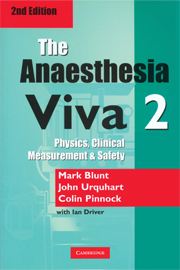Book contents
- Frontmatter
- Foreword to the First Edition
- Preface to the Second Editions
- Contents
- Physics, Clinical Measurement & Safety
- Clinical Anaesthesia
- Example 1
- Example 2
- 6 Example 3
- 7 Example 4
- Example 5
- Example 6
- Example 7
- Example 8
- Example 9
- Example 10
- Example 11
- Example 12
- Example 13
- Example 14
- Appendix 1
- Appendix 2
- Index
Example 5
Published online by Cambridge University Press: 05 February 2015
- Frontmatter
- Foreword to the First Edition
- Preface to the Second Editions
- Contents
- Physics, Clinical Measurement & Safety
- Clinical Anaesthesia
- Example 1
- Example 2
- 6 Example 3
- 7 Example 4
- Example 5
- Example 6
- Example 7
- Example 8
- Example 9
- Example 10
- Example 11
- Example 12
- Example 13
- Example 14
- Appendix 1
- Appendix 2
- Index
Summary
Scenario
A 48-year-old male patient presents for varicose vein surgery. He has a history of smoking 20-30 cigarettes a day since age 14. On examination you find scattered wheeze and odd coarse crepitations in all lung fields. He declares himself well but has a ‘fruity’ smoker's cough. Should patients such as this be encouraged to give up smoking before anaesthesia when surgery is not essential?
Basically-yes! There are immediate, short-term and long-term reasons to cease smoking prior to anaesthesia.
Smokers are more likely to desaturate in recovery, as are the passive-smoking children of smoking parents.
Immediate reasons: These relate to oxygen delivery
The half-life of carboxyhaemoglobin (COHb) is 250 minutes in room air; COHb displaces oxygen from haemoglobin, but is not detected by pulse oximetry, which reads COHb as HbO. A heavy smoker (60/day) may have a COHb of 15%, so that his or her HbO is, at best, 85%. A bedside pulse oximetry reading of 92% clearly indicates much worse hypoxia in such a case. This has obvious implications for oxygen delivery. Nicotine is a sympathetic stimulant, so there is a chance of accelerated cardiac function in the context of reduced oxygen delivery. Abstinence from smoking for 12 hours restores oxygen carriage to that of the non-smoker.
Short term reasons: These mostly relate to pulmonary function
Smokers have increased pulmonary secretions and airway sensitivity.
- Type
- Chapter
- Information
- The Anaesthesia Viva , pp. 96 - 99Publisher: Cambridge University PressPrint publication year: 2003

